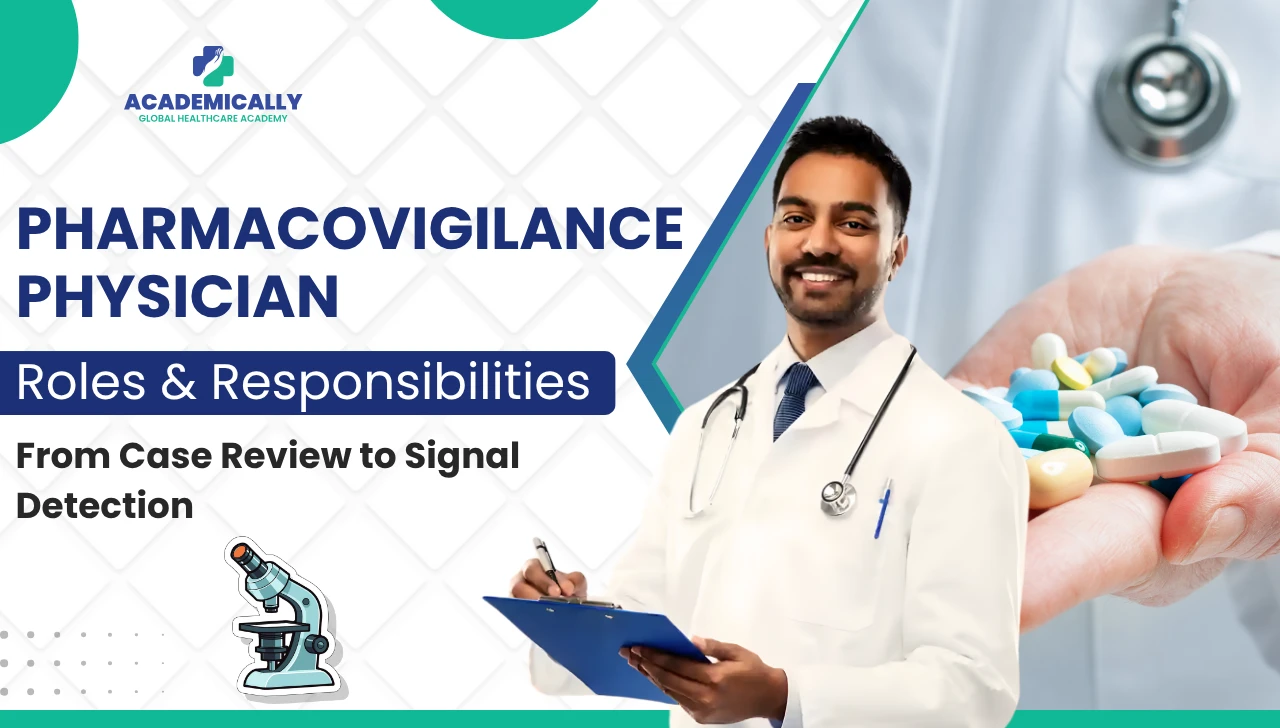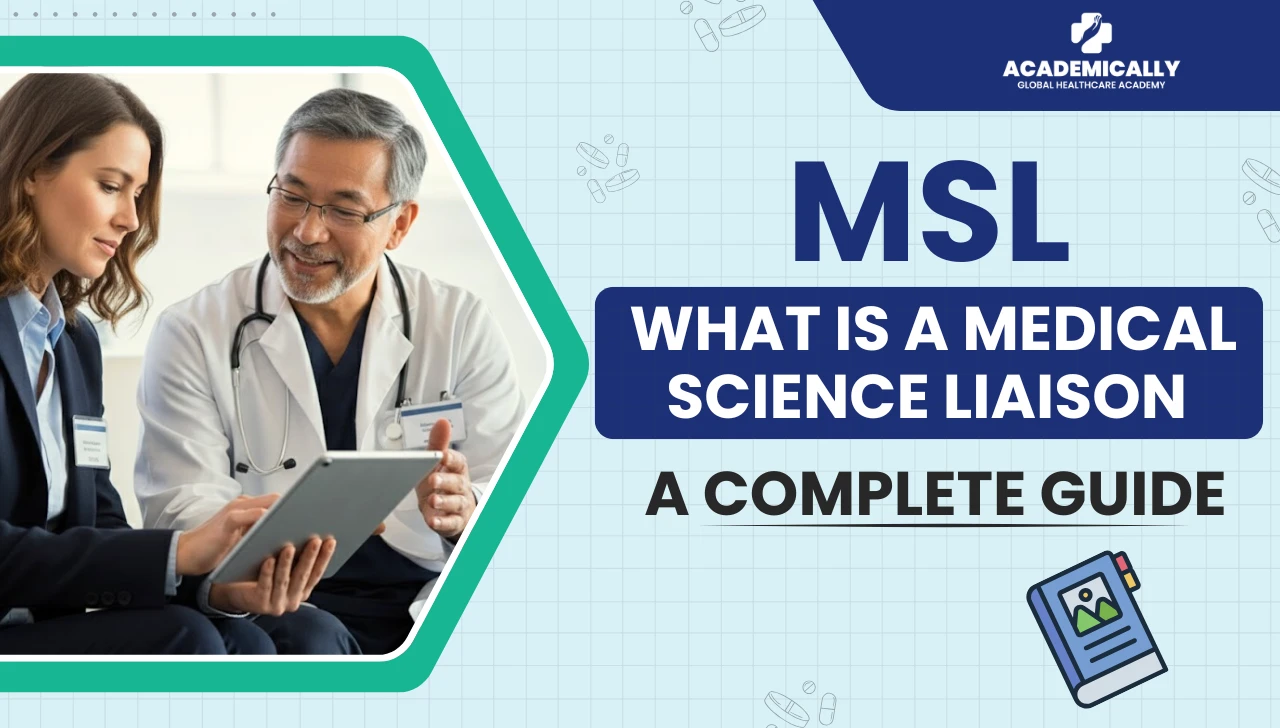Pharmacovigilance physicians sit at the crossroads of medicine, data, and ethics. They act as part detective, part data scientist, and all clinician. They’re the guardians who ensure that once a drug leaves the lab, it continues to help more than it harms. Their world blends clinical reasoning with curiosity. They work to transform patient stories into regulatory insights that protect lives.
If you think this sounds like a desk job with paperwork, think again. It’s equal parts medicine, strategy, and impact.
This blog will dive into the world of a PV physician. The ones who continue to save lives, even when not working bedside.
Pharmacovigilance Physician Role: What Do They Do?
A Pharmacovigilance Physician is also called a Drug Safety Physician. They are responsible for monitoring and evaluating adverse events related to pharmaceutical products. Their goal? To ensure medicines remain as safe as possible throughout their life cycle.
They:
- Review adverse event reports (ICSRs)
- Evaluate seriousness and causality
- Detect and validate safety signals
- Support regulatory submissions and safety documents
- Guide risk management decisions
They’re the clinicians who make sense of chaos. Connecting symptoms, data, and biology to ensure patient safety remains non-negotiable.
The Daily Balancing Act: Medicine Meets Data
A PV physician’s day swings between immediate case reviews and broader safety analysis.
1. Case Review and Causality Assessment
Here, each patient report is like a mini case study:
- Review medical history, concurrent medications, lab results, and timelines
- Decide if the adverse event is related to the drug or disease
- Classify its seriousness and expectedness
- Ensure the report meets regulatory standards for expedited submission
This is where medical intuition shines. The knowledge of when “just a coincidence” isn’t just a coincidence.
2. Signal Detection and Validation
Once individual cases are reviewed, patterns start to emerge. PV physicians use:
- Databases like VigiBase or EudraVigilance
- Statistical tools (like disproportionality analysis)
- Literature and epidemiological studies
A flagged pattern is called a signal. It’s an early warning that something might be wrong. The physician then validates it, looking for biological plausibility and real-world relevance.
In short, numbers whisper; physicians decide whether to listen.
How One Case Becomes a Global Warning
Here’s the journey from a single patient to a worldwide safety alert:
| Step | Process | Details |
| Step 1 | Case Collection | Reports flow in from Healthcare providers Patients Clinical trials |
| Step 2 | Medical Review | PV physicians interpret the story behind the data. |
| Step 3 | Aggregation | Similar reports are grouped together. |
| Step 4 | Signal Detection | Algorithms spot statistical anomalies. |
| Step 5 | Signal Validation | Physicians confirm clinical credibility. |
| Step 6 | Regulatory Action | Label updates Safety warnings Studies follow |
Every safety label you see on a medicine box began with this process.
Key Responsibilities Of a PV Physician
| Area | Responsibility |
| Case Review | Evaluate adverse event reports Assess seriousness Ensure accurate medical coding |
| Signal Detection | Analyze aggregated data to identify new safety concerns |
| Regulatory Reporting | Oversee expedited and periodic safety reports: PBRERs DSURs |
| Risk Management | Contribute to Risk Management Plans Benefit–risk assessments |
| Cross-functional Collaboration | Work with Clinical research Epidemiology Medical writing Regulatory teams |
| Audit and Inspection Support | Defend safety decisions during audits and ensure compliance |
Each of these roles relies heavily on clinical judgment. Something even the smartest algorithms can’t replicate.
The Skill Set That Defines a PV Physician
To excel in pharmacovigilance, doctors need to evolve from bedside clinicians to analytical strategists. Key skills include:
- Clinical reasoning: Interpret complex cases with medical insight
- Regulatory knowledge: Understand global PV laws
- Data interpretation: Read safety data and spotting patterns
- Communication: Translate medical findings into clear, concise reports
- Critical thinking: Balance evidence and uncertainty
It’s a career that rewards curiosity, logic, and lifelong learning.
Where Clinical Medicine Meets Artificial Intelligence
Artificial intelligence and automation are transforming PV, but not replacing the physician. AI tools can sift through millions of reports in seconds. However, only a clinician can judge if a statistical link makes biological sense.
As one industry expert said, “Algorithms can detect correlation; physicians detect consequence.”
That’s why human oversight will always be the final safeguard in pharmacovigilance.
Impact Beyond the Office
Pharmacovigilance physicians save lives quietly. Their decisions lead to:
- Label updates that prevent future harm
- Early recalls of dangerous drugs
- Safer clinical trials
- Smarter drug development strategies
Behind every regulatory safety alert or label change, there’s a PV physician’s signature. A story of diligence that likely prevented a tragedy.
Common Challenges in the Field
Even the best PV physicians face challenges:
- Incomplete data: Patient histories often lack crucial context.
- Confounding factors: Diseases and drugs can overlap in their effects.
- Regulatory complexity: Every country has unique rules.
- Data overload: Millions of reports, limited time.
But these challenges also make the role exciting. Each case is a mystery waiting to be solved.
Career Path and Global Opportunities
PV physicians start as medical reviewers and can grow into:
- Safety Science Leads
- Signal Detection Specialists
- Aggregate Report Authors
- Medical Safety Directors
- PV Heads or Qualified Persons for Pharmacovigilance
Global Outlook
| Country | Average Salary (USD/year) | Career Outlook |
| India | $25,000 - $40,000 (INR 22-35 LPA) | Growing rapidly with CRO and pharma hubs in Hyderabad, Pune, and Bengaluru |
| UK | $80,000 - $110,000 (INR 70- 96 LPA) | Strong demand in biotech and regulatory sectors |
| USA | $120,000 - $180,000 (INR 1-1.5 Cr) | High demand in Big Pharma and regulatory agencies |
| EU | $90,000 - $140,000 (INR 80 LPA- 1.15 Cr) | Expanding role with advanced PV analytics and risk management |
With global harmonization of PV systems, skilled physicians can build international careers faster than ever.
What Are You Waiting For?
Pharmacovigilance physicians are the clinical conscience of drug safety.
- They read the stories behind the data
- Challenge statistical hypotheses with bedside logic
- Ensure that medicines stay safe and effective
If you like medicine that minds the margins, this is where the real-world impact lives. Take the first step in this journey with Academically’s Postgraduate Certificate in Drug Safety and Pharmacovigilance for Physicians - Job Ready Program. Here, not only will you get to learn the skills, but also job assistance and career guidance.
Life is precious, and so is time. Start a challenging, fulfilling and riveting career today.



